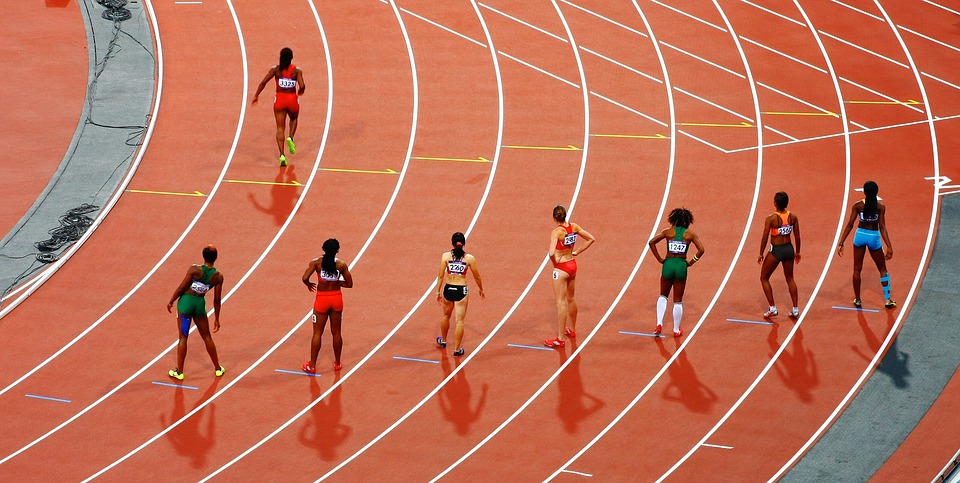Sprinting to Glory: Unleashing Athletic Prowess
The article provides a comprehensive overview of track and field, a dynamic sport encompassing a wide range of athletic disciplines. It traces the sport's historical roots in ancient Greece and its evolution into a global phenomenon. The guide explores track events, including sprints, hurdles, and relays, as well as field events like jumps, throws, and pole vaulting. It emphasizes the importance of specialized training, nutrition, and strategic thinking for success in track and field. With insights into event-specific techniques and conditioning, this article serves as a valuable resource for both aspiring and seasoned athletes in the world of track and field.
A Brief History

Track and field is a diverse and exhilarating sport that encompasses a wide range of athletic disciplines. From sprinting down the straightaways to launching objects through the air, this sport showcases the epitome of human physical prowess.
A Brief History
Track and field's origins can be traced back to ancient Greece, where it was an integral part of the Olympic Games. The ancient Greeks engaged in a variety of athletic competitions, including foot races, long jumps, discus throws, and more. Over the centuries, track and field evolved, becoming a prominent sport worldwide. Today, it is a cornerstone of both the Olympic Games and various international athletic competitions.

The Events
Track and field is divided into two main categories: track events and field events.
Track Events
Sprints
Sprints are high-speed races run over short distances. The standard sprint distances are 100 meters, 200 meters, and 400 meters. These events demand explosive power, agility, and incredible speed.
Middle-Distance and Long-Distance
Middle-distance races range from 800 meters to 1500 meters, while long-distance events encompass distances from 3000 meters to the marathon (42.195 kilometers). Athletes competing in these events require a blend of endurance, strategic pacing, and mental fortitude.
Hurdles
Hurdle events combine speed with the technical skill of hurdling. Athletes sprint down the track while negotiating a series of hurdles. The 110-meter hurdles and 400-meter hurdles are standard distances.
Relays
Relay races involve teams of four athletes passing a baton in a specified order. The most common relay distances are 4x100 meters and 4x400 meters.
Field Events
Jumps
- Long Jump: Athletes sprint down the runway and jump as far as possible into a sandpit.
- High Jump: Athletes clear a horizontal bar without knocking it down.
- Triple Jump: Combines speed, strength, and technique, involving a hop, step, and jump.
Throws
- Shot Put: Athletes propel a spherical weight as far as possible.
- Discus Throw: Involves spinning techniques to throw a heavy discus.
- Hammer Throw: Athletes swing a heavy weight on the end of a wire and release it for distance.
- Javelin Throw: In this event, athletes throw a javelin, attempting to achieve the greatest distance.
Pole Vault
Athletes use a flexible pole to clear a horizontal bar. This event demands a unique combination of speed, strength, and technical skill.
Training and Preparation
General Conditioning
Track and field athletes require a robust foundation of cardiovascular fitness, strength, flexibility, and agility. Regular conditioning exercises, such as interval training, weightlifting, and plyometrics, are crucial.
Event-Specific Training
Each track and field event demands specialized training techniques. For example:
- Sprinters focus on explosive speed and acceleration.
- Middle-distance runners emphasize endurance and speed endurance.
- Jumpers and throwers engage in event-specific drills to refine technique and power.
Nutrition and Recovery
A balanced diet that fuels performance and promotes recovery is paramount. Athletes should pay attention to macronutrient ratios, hydration, and micronutrient intake. Adequate rest and recovery are equally essential.
Competition and Strategy
Understanding race tactics, techniques, and the ability to adapt to changing circumstances are key elements of successful track and field competition. Athletes must balance explosive bursts of energy with disciplined pacing.

Frequently Asked Questions (FAQ)
1. What do we mean by track and field?
Track and field, often referred to as athletics, is a sport that includes a variety of competitive athletic events. It typically involves two main categories: track events and field events. Track events are races, usually held on a running track, while field events take place on adjacent field areas and involve jumping, throwing, or other athletic activities.
2. What do you call a track and field field?
The area where field events in track and field take place is commonly known as the "infield." This is where athletes participate in events like long jump, high jump, shot put, discus throw, pole vault, and other similar activities.
3. How many events are in a track?
A standard track typically hosts a range of track events. These can vary, but common track events include sprints (e.g., 100m, 200m), middle-distance races (e.g., 800m, 1500m), hurdles (e.g., 110m hurdles, 400m hurdles), relays (e.g., 4x100m, 4x400m), and long-distance races (e.g., 5000m, 10,000m).
4. What is an example of a field event?
An example of a field event in track and field is the "shot put." Shot put involves athletes throwing a heavy spherical object (the shot) as far as possible. Other field events include the discus throw, long jump, high jump, pole vault, triple jump, javelin throw, and hammer throw.
5. How many lines are in a standard track?
A standard running track typically has several lines. These include:
- The innermost lane, Lane 1, which is closest to the center of the track.
- The outer lanes, often labeled Lane 2, Lane 3, and so on, moving outward from the innermost lane.
- Lane markings for relay exchange zones in relay races.
6. What is the meaning of track?
In the context of track and field, a "track" refers to the oval or rectangular running surface where track events, such as sprints, middle-distance races, and hurdles, take place. The track is usually made of a synthetic material or a combination of materials, and it is divided into marked lanes for each race. It serves as the central area for running competitions in track and field.
Track and field is a sport that celebrates the diversity of human athletic ability. Whether you're a sprinter, a distance runner, a jumper, or a thrower, there's a discipline that can become your forte. By embracing a combination of training, discipline, and strategic thinking, you can excel in this dynamic and thrilling sport. So, lace up those spikes and step onto the track – your journey in track and field awaits!



